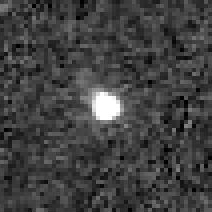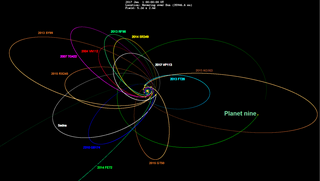Related Research Articles
(65407) 2002 RP120, provisional designation 2002 RP120, is a trans-Neptunian object and damocloid from the outer Solar System. Its orbit is retrograde and comet-like, and has a high eccentricity. It was discovered on 4 September 2002 by astronomers with the LONEOS survey at Anderson Mesa Station, Arizona, in the United States. The unusual object measures approximately 14.6 kilometers (9.1 miles) in diameter and is likely elongated in shape. It is a slow rotator and potentially a tumbler as well. The object was probably ejected from the ecliptic by Neptune.

(40314) 1999 KR16 is a trans-Neptunian object on an eccentric orbit in the outermost region of the Solar System, approximately 254 kilometers (158 miles) in diameter. It was discovered on 16 May 1999, by French astronomer Audrey Delsanti and Oliver Hainaut at ESO's La Silla Observatory in northern Chile. The very reddish object is a dwarf planet candidate and has a rotation period of 11.7 hours.
(181902) 1999 RD215 is a trans-Neptunian object of the scattered disc, approximately 148 kilometers in diameter. It was discovered on 6 September 1999, by American astronomers Chad Trujillo, Jane Luu, and David Jewitt at the Mauna Kea Observatories, Hawaii.
(589683) 2010 RF43 (provisional designation 2010 RF43) is a large trans-Neptunian object orbiting in the scattered disc in the outermost regions of the Solar System. The object was discovered on 9 September 2010, by American astronomers David Rabinowitz, Megan Schwamb and Suzanne Tourtellotte at ESO's La Silla Observatory in northern Chile.
(445473) 2010 VZ98 (provisional designation 2010 VZ98) is a trans-Neptunian object of the scattered disc, orbiting the Sun in the outermost region of the Solar System. It has a diameter of approximately 400 kilometers.
(523645) 2010 VK201 (provisional designation 2010 VK201) is a trans-Neptunian object and member of the classical Kuiper belt, approximately 500 kilometers (310 miles) in diameter. It was discovered on 1 November 2010, by the Pan-STARRS 1 survey at Haleakala Observatory, Hawaii, United States. It has a rotation period of 7.6 hours. It was numbered in September 2018 and remains unnamed.

(523692) 2014 EZ51 (provisional designation 2014 EZ51) is a large trans-Neptunian object in the scattered disc, approximately 700 kilometres (430 miles) in diameter. It was discovered on 18 April 2010, by the Pan-STARRS 1 survey at Haleakala Observatory, Hawaii, United States.

2015 RX245 is an extreme trans-Neptunian object, detached, on a highly eccentric orbit in the outermost region of the Solar System. It measures approximately 250 kilometers (160 miles) in diameter and is "possibly" a dwarf planet. It was first observed on 8 September 2015, by astronomers with Outer Solar System Origins Survey using the 3.6-meter Canada–France–Hawaii Telescope at Mauna Kea Observatories, Hawaii, in the United States.
2010 WG9 is a high inclination trans-Neptunian object and slow rotator from the outer Solar System, approximately 100 kilometers in diameter. It was first observed at ESO's La Silla Observatory in northern Chile on 30 November 2010.
2005 RH52 is an extreme trans-Neptunian object from the extended scattered disc in the outermost region of the Solar System, approximately 130 kilometers (81 miles) in diameter. It was first observed on 3 September 2005, by astronomers with the Canada–France Ecliptic Plane Survey using the Canada–France–Hawaii Telescope at the Mauna Kea Observatories in Hawaii, United States.

2013 FS28 is an extreme trans-Neptunian object from the extended scattered disc on a highly eccentric orbit in the outermost region of the Solar System. It measures approximately 466 kilometers (290 miles) in diameter. The detached, extended scattered disc object belongs to the group of extreme trans-Neptunian objects. It was first observed on 16 March 2013, by American astronomers Scott Sheppard and Chad Trujillo at the Cerro Tololo Observatory in Chile.
(527603) 2007 VJ305, provisional designation 2007 VJ305, is an extrem trans-Neptunian object from the extended scattered disc on a highly eccentric orbit in the outermost region of the Solar System. It measures approximately 250 kilometers (160 miles) in diameter and is "possibly" a dwarf planet. The rather reddish extended scattered disc object belongs to the group of extreme trans-Neptunian objects. It was discovered on 4 November 2007 by astronomers Andrew Becker, Andrew Puckett and Jeremy Kubica at the Apache Point Observatory in New Mexico, United States.
2013 UH15 is an extreme trans-Neptunian object from the extended scattered disc in the outermost region of the Solar System, approximately 130 kilometers (81 miles) in diameter. It was first observed on 29 October 2013, by astronomers at the Las Campanas Observatory in the southern Atacama Desert of Chile. The detached extended scattered disc object (ESDO) is on a highly eccentric orbit and belongs to the extreme trans-Neptunian objects.
(468861) 2013 LU28, provisional designation 2013 LU28 is a highly eccentric trans-Neptunian object, retrograde centaur and damocloid from the outer regions of the Solar System. It was discovered on 8 June 2013 by astronomers with the Mount Lemmon Survey at the Mount Lemmon Observatory in Arizona, United States. The object is unlikely a dwarf planet as it measures approximately 110 kilometers (68 miles) in diameter. It was numbered in 2016 and has not been named since.
(501581) 2014 OB394, provisional designation 2014 OB394, is a trans-Neptunian object from the outermost region of the Solar System, approximately 260 kilometers (160 miles) in diameter. It was discovered on 25 August 2012, by astronomers with the Pan-STARRS survey at Haleakala Observatory, Hawaii, United States. The weak dwarf planet candidate was numbered in 2017 and remains without a name.
(501546) 2014 JJ80, prov. designation:2014 JJ80, is a trans-Neptunian object from the outermost region of the Solar System. It was discovered on 9 July 2013, by astronomers with the Pan-STARRS survey at Haleakala Observatory, Hawaii, United States. It is a dwarf planet candidate, as it measures approximately 350 kilometers (220 miles) in diameter.
(523706) 2014 HF200, provisional designation 2014 HF200, is a trans-Neptunian object on an eccentric orbit from the scattered disc, located in the outermost region of the Solar System. It was discovered on 20 May 2012, by astronomers with the Pan-STARRS survey at Haleakala Observatory, Hawaii, United States. The dwarf planet candidate measures approximately 300 kilometers (190 miles) in diameter.
(523702) 2014 HW199 (provisional designation 2014 HW199) is a trans-Neptunian object from the classical Kuiper belt, located in the outermost region of the Solar System. It was discovered on 30 January 2011, by astronomers with the Pan-STARRS survey at Haleakala Observatory, Hawaii, United States. The classical Kuiper belt object is also a dwarf planet candidate, as it measures approximately 290 kilometers (180 miles) in diameter.
(523683) 2014 CP23, provisional designation 2014 CP23, is a trans-Neptunian object from the scattered disc located in the outermost region of the Solar System It was discovered on 29 October 2011, by astronomers with the Pan-STARRS survey at Haleakala Observatory, Hawaii, United States. The dwarf planet candidate measures approximately 267 kilometers (170 miles) in diameter.
(495603) 2015 AM281 (provisional designation 2015 AM281) is a resonant trans-Neptunian object in the outermost region of the Solar System, guesstimated at approximately 470 kilometers (290 miles) in diameter. It was discovered on 13 March 2010, by astronomers with the Pan-STARRS survey at Haleakala Observatory, Hawaii, United States.
References
- 1 2 3 4 5 6 "JPL Small-Body Database Browser: (2010 TJ)" (2017-12-20 last obs.). Jet Propulsion Laboratory . Retrieved 17 January 2018.
- ↑ "List Of Centaurs and Scattered-Disk Objects". Minor Planet Center. Retrieved 17 January 2018.
- 1 2 3 4 5 6 Johnston, Wm. Robert (15 October 2017). "List of Known Trans-Neptunian Objects". Johnston's Archive. Retrieved 17 January 2018.
- 1 2 3 4 "2010 TJ". Minor Planet Center. Retrieved 17 January 2018.
- 1 2 3 4 5 Michael E. Brown. "How many dwarf planets are there in the outer solar system?". California Institute of Technology . Retrieved 17 January 2018.
- ↑ "LCDB Data for (2010 TJ)". Asteroid Lightcurve Database (LCDB). Retrieved 17 January 2018.

